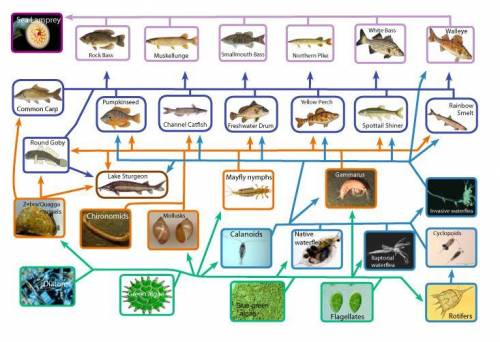
Biology, 31.03.2020 01:08 typicalemi4634
Modeling a Food Web
In this activity, you will build a model of a food web in a specific aquatic ecosystem. You will then use the model to explain what can happen to the competition in the ecosystem if environmental factors change because of natural factors and human interference.
Part A
Begin by selecting a freshwater or marine aquatic ecosystem as a model for your food web. Be specific. Choose a specific lake. Or, if you choose an ocean ecosystem, identify its geographical area and depth. Keep in mind that deep-sea organisms live in a completely different environment than surface aquatic organisms.
Next, conduct research on the following conditions in the ecosystem you chose. They influence the types of organisms that can live there.
geographical features
temperature
depth/light availability
salinity
pH
unique features that contribute to the ecosystem, such as other bodies of water that connect to it, unusual chemistry, and climate
Using the information you gathered, write a paragraph that describes conditions in the ecosystem.
Part B
Now conduct research on the types of organisms that live in the ecosystem you chose. Note that quaternary consumers and even tertiary consumers can include land animals that rely on the animals in the aquatic ecosystem for food. Collect information based on these guidelines:
Producers: Identify 2-3 species.
Primary (or first-level) consumers: Identify 2-3 species.
Secondary (or second-level) consumers: Identify 2-3 species.
Tertiary (or third-level) consumers: Identify 2-3 species.
Quaternary (or fourth-level) consumers: Identify 1-2 species.
Write down the species you’ve identified for each consumer level in the ecosystem.
Part C
Using the organisms you identified in part B, create a food web for the ecosystem you chose. Use this sample food web for reference, although your food web will contain fewer organisms. Note that your food web does not have to include images, but you may include them if you choose. However, be sure to include arrows to indicate the direction of energy flow in your food web. Design your food web using any method listed below:
Use drawing or flowchart-building tools in a word-processing program.
Hand draw your food web, and then take a picture of it.
Use a graphic-design program.
Using the Insert Image button, insert an image of your food web in the answer space.
Part D
Changes in ecosystems can be attributed to natural causes, such as natural disasters, seasonal variations in climate, currents, and tidal activity. Many of these changes can affect the amount of food resources available in an ecosystem. Research one natural change that currently affects or could affect the aquatic ecosystem you chose. Use your food web model to explain how this change can affect the competition of food resources in your aquatic ecosystem.
Part E
In addition to natural factors, human activity can also alter ecosystems. Conduct research on a human activity that currently affects or can theoretically affect your chosen ecosystem. Use your food web model to explain how this change can affect the competition for food resources.


Answers: 1


Another question on Biology


Biology, 21.06.2019 21:00
Round peas are dominant to wrinkled. what would you cross a round pea with to determine if it were heterozygous or homozygous dominant? why? ?
Answers: 2

Biology, 22.06.2019 06:10
Which process of living things produces water that enters the water cycle
Answers: 1

Biology, 22.06.2019 08:30
Gene expression is the activation of a gent that results in a question 1 options: protein dna mitochondria
Answers: 1
You know the right answer?
Modeling a Food Web
In this activity, you will build a model of a food web in a specific...
In this activity, you will build a model of a food web in a specific...
Questions

History, 02.01.2020 07:31



Biology, 02.01.2020 07:31

Health, 02.01.2020 07:31

Health, 02.01.2020 07:31


Mathematics, 02.01.2020 07:31


Mathematics, 02.01.2020 07:31

History, 02.01.2020 07:31

Mathematics, 02.01.2020 07:31

Health, 02.01.2020 07:31






Physics, 02.01.2020 07:31

Computers and Technology, 02.01.2020 07:31



